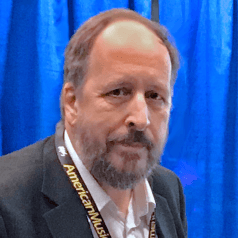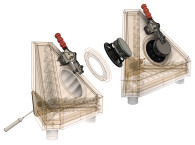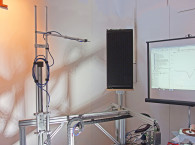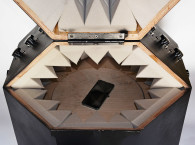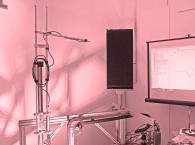
Once I had a Tetrahedral Test Chamber (TTC) design that satisfied all the criteria, I needed to bring together a team to get it into production. Alan Slaughter took on the QC and Tom Ayre translated my concept into a set of working 3D CAD drawings for the initial chamber. Alan began searching suppliers who could tackle the complex manufacture of the chamber.
We then set about building the first test chamber that could handle drivers up to 12”. At this time, the Audio Engineering Society (AES) was about to hold its 51st Loudspeaker and Headphone Conference in Helsinki, Finland, in August 2013, so we loaded our TTC900 test chamber into the back of Alan’s VW hatchback and headed off to Helsinki.
Eventually we arrived at Helsinki, a day later than planned after missing a ferry on our last leg of the journey. We were just in time for the conference where I planned to demonstrate the chamber. Outside the meeting room there was a series of deep cabinets stretching along one wall where several other people were setting up. Recognizing Wolfgang Klippel in whom I had confided earlier, I set up alongside him.

Although the chamber was not formally on the agenda—there was quite a bit of interest in the idea and particularly in the consistency of results that even this prototype was capable of demonstrating repeatedly... flat 2Hz to 15kHz. Unheard of!
The next few days were very hectic, and I was unable to attend several presentations and papers that I wished to join. Many people were stopping in the hallway where we were set up and enquiring about the chamber and how it worked, even during the sessions! People were especially interested in the consistency and stability, and wanted to know what it could achieve.
This was successfully demonstrated by measuring first a bass-mid drive unit, saving the results and then changing to a tweeter using a different sub-baffle and saving those results. Then, we changed back to the first bass-mid driver and compared the results, displaying the difference curve between these measurements. Each time we made a measurement, no matter who swapped the drivers, the results were consistent over the full 20Hz to 20kHz range. As the days went by, it became obvious how stable and consistent the results were. They were within ±2dB 20Hz to 20kHz over the course of three full days.
At the AES conference, several people made some particularly useful comments. Peter Larsen, founder of Loudsoft, suggested that the minimum mic-to-baffle distance should not be less than the driver diameter and therefore to use 10cm, 31.6cm, and 100cm as standard distances as these also correspond to 20dB, 10dB, or 0dB gain steps compared to the standard 1m measurement distance.
Jorge Moreno Ruiz, Dean of Pontifical Catholic University of Peru (PUCP), suggested looking at Don Keele’s work on low-frequency loudspeaker measurements, and this started me on the quest to accurately equalize a tetrahedral test chamber.
Also, during the conference, I talked to Sean Olive of Harman, who was AES President at the time. After demonstrating the TTC to him, he asked whether or not I would be showing it at the AES convention in New York. When I commented that I was too late as papers had been required two months previously, Sean said “leave that with me...”
Thanks to Sean, the TTC was submitted as an Engineering Brief to the AES 135th convention in NY and we decided to demonstrate the scalability of the concept with another chamber, the TTC350.

The AES 135th Convention in New York
So, it was back to the UK to start the process of designing a smaller chamber, the TTC350. At least this time we had a template, so while Tom worked with the 3D CAD, I concentrated on modeling the performance using Joerg Panzer’s ABEC and VACS software, this laid out the underlying theory, which I then included in an AES Engineering Brief to be presented in New York.
At the convention Wolfgang Klippel offered to make room for the TTC350 on his stand and I presented my EB123 engineering brief in the program and raised the concept with the AES Standards Committee 04-03—Loudspeakers and Headphones. Ed Simon and I presented independent proposals for measuring loudspeaker drivers. After seeing the Tetrahedral Chamber, Ed commented that the TTC was a “No Brainer” as it yielded better and more consistent results plus it was conceptually simpler and substantially smaller than his proposal.
At this meeting, Ed proposed the Project AES-X223 report on loudspeaker driver comparison chambers and the committee requested I produce content for a paper on suggested designs and construction methods for loudspeaker driver comparison chambers for the next AES convention in Berlin, Germany, in six months.
Subsequently, after the standards meeting many of the SC 04-03 committee members came to examine the Tetrahedral enclosure at the stand, one conversation that stood out was with Laurie Fincham of THX who asked, “Geoff, why did you get involved with all of this?” I replied, “Well Laurie, I could not afford an anechoic chamber.” Laurie’s reply surprised me: “No, none of us can!”
After the 135th convention, I continued work on the X223 report as requested, supporting this with an updated Engineering Brief EB143, which I previewed to the SC 04-03 committee at the 136th convention in Berlin in April 2014.
I submitted the data to the standards committee as my input to the X223 report. After much discussion, Mark Yonge, who was the AES Standards Manager at the time, felt that the importance of my engineering brief was more suited to an Information Document. Within the context of an AES Standards Committee, an Information Document goes through an extensive peer review, which can often take years and validates the proposed document. So, at the 136th convention the project X223 was changed from a report to an Information Document, with AES 73id-2019 being formally issued by the AES validating the TTC concept.

The Final Tweaks
Between 2014 and 2018 there was an extensive period of refining the detailed design and manufacture of the TTCs. This included demonstrations at numerous conventions and conferences measuring a wide range of speaker drivers from 2” up to 15” to audiences in Berlin, UK, Las Vegas, NV, Los Angeles, CA, China, Hong Kong, India, France, Spain, Denmark, Ireland and back to New York. One photo shows a large chamber, the TTC1500, being used in India. Alongside is Palani Loganathan of Analogan in India. The TTC1500 is capable of measuring a 21” loudspeaker driver or a complete loudspeaker enclosure and TTCs are fully scalable for any size driver. Another photo shows a smaller chamber the TTC350 fitted with an Acoustic Isolator open (a) and with the Acoustic Isolator closed (b).
At some of these venues, I made presentations and submitted papers to the AES, ISEAT, ALMA (now ALTI) working with: Audio Precision, Audiomatica CLIO, Etani, HolmImpulse, Klippel, Listen, Inc., Loudsoft, MLSSA, NTi, and Prism Sound (now Spectral Measurement). During this time, I published a white paper (See references/audioXpress’ Supplementary Materials) on the TTCs, which is included in my book Loudspeaker Modelling and Design a Practical Introduction.

Further Validation
After an extensive peer review process, the concept has now been accepted as a part of the international IEC standards—IEC 60268-21-2018 and IEC 60268-22-2020—and the AES issued AES73id-2019 in which David Murphy of Krix, collaborated with me to mathematically prove the measurement stability achievable with loudspeaker test chambers, with the TTC being used as an example. The TTC routinely produced results with stability of better than ±0.5dB, 20Hz to 20kHz (95% confidence), calculated by internationally accepted statistical principles.

Conclusion
Starting from simple wavelength theory and Leo Beranek’s wedges, tetrahedral structure, measurement theory, and building upon my experience gained in designing chambers in Europe, US, and Asia, the TTC chamber was born.
It’s surprising that the concepts behind the TTC were not harnessed earlier as it is a “game-changer” in the way that we can measure loudspeakers of any size and shape. The loudspeaker test chambers are in use throughout the world, providing consistent, reliable, and accurate measurements of loudspeaker transducers and loudspeaker systems without the cost, complexity, and space requirements of an anechoic chamber, and independent of the test analyzer.
TTCs are available commercially through Spectral Measurement (formerly the Test & Measurement division of Prism Sound), which signed a licensing deal with Hill Acoustics enabling it to manufacture the chambers. aX
Author’s Acknowledgement: During my years of developing the concept of the Tetrahedral Test Chamber, bringing it into use, and having it validated by its inclusion in international standards, I have benefited from the invaluable insights and wealth of constructive suggestions of my peers including engineers, loudspeaker measurement instrument manufacturers, and end users who reflected on my explanation of the concept and allowed me the time to demonstrate the TTC to them first hand. For that reason, I would like to thank: Tom Ayre, Dave Berriman, Graham Boswell, Peter Brooks, Vance Dickason, Laurie Fincham, Dan Foley, Su Hill, Steve Hutt, Stefan Irrgang, Don Keele, Wolfgang Klippel, Phil Knight, Peter Larsen, Patrick Macey, João Martins, Thomas Mintner, David Murphy, Bruce Olson, Doug Ordon, Ismo Pänkäläinen, Joerg Panzer, Jorge Moreno Ruiz, Gregor Schmidle, Philipp Schwizer, Ed Simon, Alan Slaughter, Bob Sturgeoner, Steve Temme, and Mark Yonge.
Click here for Part 1 of this article.
Project Files
To download additional material and files, visit the audioXpress Supplementary Material page.
Resources
AES73id - AES information document for acoustics—Loudspeaker driver comparison chambers
G. Hill, Loudspeaker Modelling and Design a Practical Introduction, Routledge/Focal Press, 2018.
www.routledge.com/Loudspeaker-Modelling-and-Design-A-Practical-Introduction/Hill/p/book/9780815361336
G. Hill, “A Guide for Building Your Own Test Chamber,” audioXpress, September 2020.
IEC60268-21:2018—Sound system equipment—Part 21: Acoustical (output-based) measurements
IEC60268-22:2020 Sound system equipment—Part 22: Electrical and mechanical measurements on transducers
This article was originally published in audioXpress, October 2021


